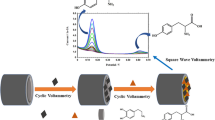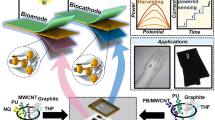Abstract
The authors demonstrate a non-enzymatic sensor for glucose that is making used of an electrode prepared from an ink composed of CuO, reduced graphene oxide and carbon nanotube (CuO/rGO/CNT) on various substrates via dipping and drying. The morphology of the CuO/rGO/CNT composite was characterized via scanning electron microscopy and its composition was confirmed via X-ray diffraction measurements. The stacking of individual rGO sheets is prevented in the rGO and CNT hybrid, and this creates large surface areas and allows for fast electron and mass transport. The composite was deposited on nickel foam and the resulting electrode is shown to be a viable amperometric sensor for glucose, with a sensitivity of 9278 μA⋅mM−1⋅cm−2 over the 10 to 1000 μM glucose concentration range. The sensor was applied to the determination of glucose in spiked human serum samples.

A non-enzymatic sensor for glucose that is making used of an electrode prepared from an ink composed of CuO, reduced graphene oxide and carbon nanotube on various substrates via facile dipping and drying.





Similar content being viewed by others
References
Chen X, Wu G, Cai Z, Oyama M, Chen X (2013) Advances in enzyme-free electrochemical sensors for hydrogen peroxide, glucose, and uric acid. Microchim Acta 180:161–186. doi:10.1007/s00604-012-0923-1
Wang G, He X, Wang L, Gu A, Huang Y, Fang B, Geng B, Zhang X (2013) Non-enzymatic electrochemical sensing of glucose. Microchim Acta 180:161–186. doi:10.1007/s00604-012-0923-1
Zhong A, Luo X, Chen L, Wei S, Liang Y, Li X (2015) Enzyme-free sensing of glucose on a copper electrode modified with nickel nanoparticles and multiwalled carbon nanotubes. Microchim Acta 182:1197–1204. doi:10.1007/s00604-014-1443-y
Shi W, Ma Z (2010) Amperometric glucose biosensor based on a triangular silver nanoprisms/chitosan composite film as immobilization matrix. Biosens Bioelectron 26:1098–1103. doi:10.1016/j.bios.2010.08.072
Bai H, Han M, Du Y, Bao J, Dai Z (2010) Facile synthesis of porous tubular palladium nanostructures and their application in a nonenzymatic glucose sensor. Chem Commun 46:1739–1741. doi:10.1039/B921004K
Zhang W-D, Chen J, Jiang L-C, Yu Y-X, Zhang J-Q (2010) A highly sensitive nonenzymatic glucose sensor based on NiO-modified multi-walled carbon nanotubes. Microchim Acta 168:259–265. doi:10.1007/s00604-010-0288-2
Jung H, Lee SH, Yang J, Cho M, Lee Y (2014) Ni (OH) 2@ Cu dendrite structure for highly sensitive glucose determination. RSC Adv 4:47714–47720. doi:10.1039/c4ra05521g
Yang J, Cho M, Lee Y (2016) Synthesis of hierarchical NiCo2O4 hollow nanorods via sacrificial-template accelerate hydrolysis for electrochemical glucose oxidation. Biosens Bioelectron 75:15–22. doi:10.1016/j.bios.2015.08.008
Lee SH, Yang J, Han YJ, Cho M, Lee Y (2015) Rapid and highly sensitive MnOx nanorods array platform for a glucose analysis. Sensors Actuators B 218:137–144. doi:10.1016/j.snb.2015.05.005
Fan Z, Liu B, Li Z, Ma L, Wang J, Yang S (2014) One-pot hydrothermal synthesis of CuO with tunable morphologies on Ni foam as a hybrid electrode for sensing glucose. RSC Adv 4:23319–23326. doi:10.1039/c3ra47422d
Cao F, Gong J (2012) Nonenzymatic glucose sensor based on CuO microfibers composed of CuO nanoparticles. Anal Chim Acta 723:39–44. doi:10.1016/j.aca.2012.02.036
Zhu J, Li D, Chen H, Yang X, Lu L, Wang X (2004) Highly dispersed CuO nanoparticles prepared by a novel quick-precipitation method. Mater Lett 58:3324–3327. doi:10.1016/j.matlet.2004.06.03
Reitz E, Jia W, Gentile M, Wang Y, Lei Y (2008) CuO nanospheres based nonenzymatic glucose sensor. Electroanalysis 20:2482–2486. doi:10.1002/elan.200804327
Wang G, Wei Y, Zhang W, Zhang X, Fang B, Wang L (2010) Enzyme-free amperometric sensing of glucose using Cu-CuO nanowire composites. Microchim Acta 168:87–92. doi:10.1002/chem.200501051
Cherevko S, Chung CH (2010) The porous CuO electrode fabricated by hydrogen bubble evolution and its application to highly sensitive non-enzymatic glucose detection. Talanta 80:1371–1377. doi:10.1016/j.talanta2009.09.038
Jiang L-C, Zhang W-D (2010) A highly sensitive nonenzymatic glucose sensor based on CuO nanoparticles-modified carbon nanotube electrode. Biosens Bioelectron 25:1402–1407. doi:10.1016/j.bios.2009.10.038
Wu H-X, Cao W-M, Li Y, Liu G, Wen Y, Yang H-F et al (2010) In situ growth of copper nanoparticles on multiwalled carbon nanotubes and their application as non-enzymatic glucose sensor materials. Electrochim Acta 55:3734–3740. doi:10.1016/j.electacta.2010.02.017
Purushothaman KK, Saravanakumar B, Babu IM, Sethuraman B, Muralidharan G (2014) Nanostructured CuO/reduced graphene oxide composite for hybrid supercapacitors. RSC Adv 4:23485–23491. doi:10.1039/c4ra02107j
Sarkar C, Dolui SK (2015) Synthesis of copper oxide/reduced graphene oxide nanocomposite and its enhanced catalytic activity towards reduction of 4-nitrophenol. RSC Adv 5:60763–60769. doi:10.1016/j.snb.2009.09.067
Wang S, Liu E, Zhang X (2014) Non-enzymatic glucose biosensor based on copper oxide-reduced graphene oxide nanocomposites synthesized from water-isopropanol solution. Electrochim Acta 130:253–260. doi:10.1016/j.electacta.2014.03.030
Nayak P, Nair SP, Ramaprabhu S (2016) Enzyme-less and low-potential sensing of glucose using a glassy carbon electrode modified with palladium nanoparticles deposited on graphene-wrapped carbon nanotubes. Microchim Acta. doi:10.1007/s00604-015-1729-8
Sun T, Zhang Z, Xiao J, Chen C, Xiao F, Wang S, et al. (2013) Facile and green synthesis of palladium nanoparticles-graphene-carbon nanotube material with high catalytic activity. Sci Rep 3. doi: 10.1038/srep02527
Sun H, Xu Z, Gao C (2013) Multifunctional, ultra‐flyweight, synergistically assembled carbon aerogels. Adv Mater 25:2554–25560. doi:10.1002/adma.201204576
Zhang Z, Sun T, Chen C, Xiao F, Gong Z, Wang S (2014) Bifunctional nanocatalyst based on three-dimensional carbon nanotube–graphene hydrogel supported pd nanoparticles: one-pot synthesis and its catalytic properties. ACS Appl Mater Interfaces 6:21035–21040. doi:10.1021/am505911h
Kung C-W, Cheng Y-H, Ho K-C (2014) Single layer of nickel hydroxide nanoparticles covered on a porous Ni foam and its application for highly sensitive non-enzymatic glucose sensor. Sensors Actuators B 204:159–166. doi:10.1016/j.snb.2014.07.102
Zhao Y, Song X, Song Q, Yin Z (2012) A facile route to the synthesis copper oxide/reduced graphene oxide nanocomposites and electrochemical detection of catechol organic pollutant. Cryst Eng Commun 14:6710–6719. doi:10.1039/C2CE25509J
Ye D, Liang G, Li H, Luo J, Zhang S, Chen H, Kong J (2013) A novel nonenzymatic sensor based on CuO nanoneedle/graphene/carbon nanofiber modified electrode for probing glucose in saliva. Talanta 116:223–230. doi:10.1016/j.talanta.2013.04.008
Acknowledgments
This study was supported by the Energy Efficiency & Resources of the Korea Institute of Energy Technology Evaluation and Planning (KETEP) grant funded by the Korea government Ministry of Knowledge Economy (No. 20142010102690) and by Ministry of Science, ICT and Futrue Planning of Korea (Grant no. 2016–228389).
Author information
Authors and Affiliations
Corresponding authors
Ethics declarations
The author(s) declare that they have no competing interests.
Additional information
Misuk Cho and Youngkwan Lee contributed equally to this work.
Electronic supplementary material
Below is the link to the electronic supplementary material.
ESM 1
(DOCX 937 kb)
Rights and permissions
About this article
Cite this article
Lee, C., Lee, S.H., Cho, M. et al. Nonenzymatic amperometric glucose sensor based on a composite prepared from CuO, reduced graphene oxide, and carbon nanotube. Microchim Acta 183, 3285–3292 (2016). https://doi.org/10.1007/s00604-016-1984-3
Received:
Accepted:
Published:
Issue Date:
DOI: https://doi.org/10.1007/s00604-016-1984-3




